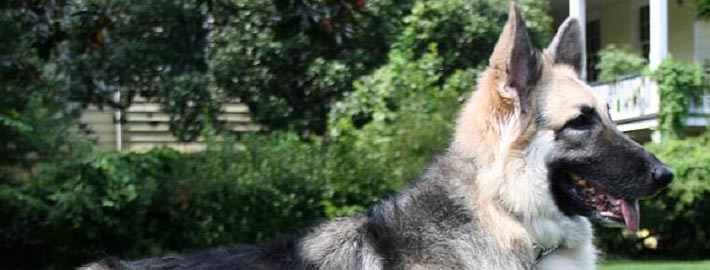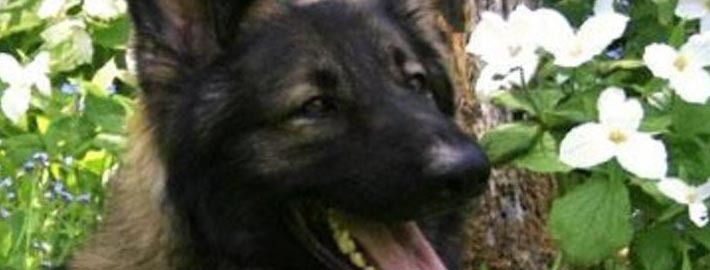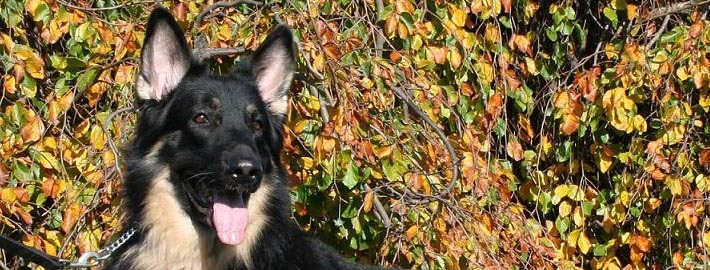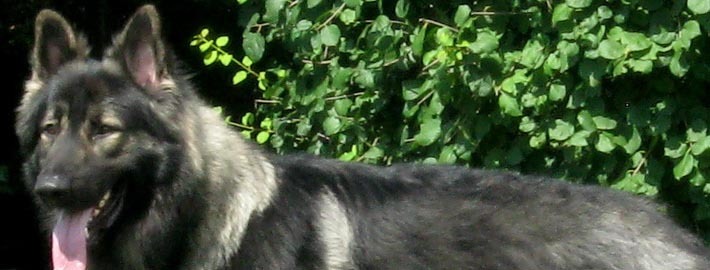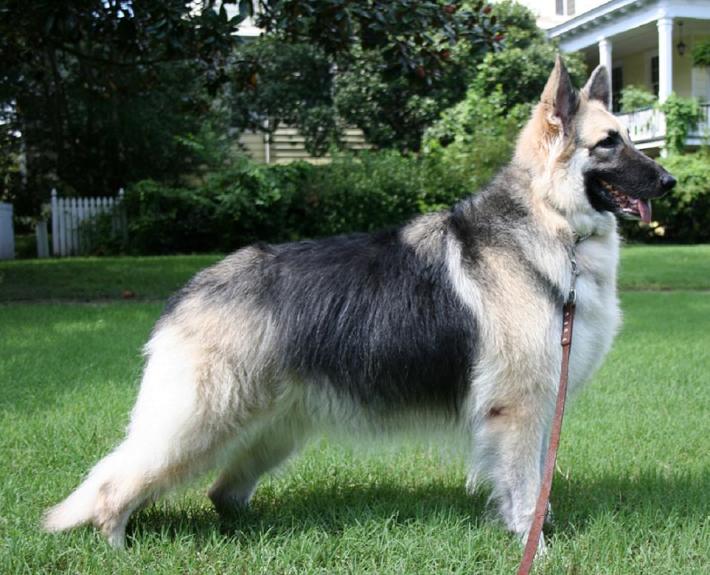What makes the Shiloh Shepherd Dog Unique?
The Shiloh shepherd descends from the foundation lines of Shiloh-Emmview’s Kara Lobo, a stock of very tall, leggy, wolf-like sables, which were crossed with the Old Württemberger Shepherd dogs, to improve bone size and hip quality. Apart from these carefully selected old-style German Shepherd dogs, Tina Barber infused some Malamute blood into her breeding stock to improve hips and increase size of the breed. The amount of Malamute blood is negligable as the lines were not directly outcrossed to a Malamute. Instead a MAW was used, i.e. a special cross of a Giant Malamute, an Alt Deutcher Shaeferhunde (old-style GSD) and a White GSD. Thus, the MAW dog itself only carried approximately 1/4 of malamute blood, and his direct offspring in the early 90’s only had 1/8 of Malamute blood in them.
Breed Groups
Page Contents
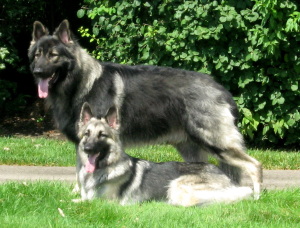
SnapShot
| Size: | Males – 28-30 inches(71-76 cm) Females – 26-28 inches(66-71 cm) |
| Weight: | Males – 120 to 140 pounds (54–65 kg) Females – 100 to 120 pounds (45-54.5 kg) |
| Origin: | United States of America |
| Life Span: | 9 – 14 Years |
| Colour: | Black , Tan, Gray, Golden Tan, Reddish tan, Silver, Cream, Red, Dark brown, Dark gray, Black sables. |
| Litter Size: | 5 – 10 puppies |
Is the Shiloh Shepherd Dog Right For You?
The Shiloh Shepherd is a calm, very intelligent, even-tempered dog that was developed to restore the stable temperament and superior size of the German Shepherd as it existed decades ago in Germany. Loyal, loving and confident, this breed is suitable for both single individuals or large families with children. Although definitely a dog that is large in physical stature, your puppy will also have a huge heart that’s full of love and devotion. This is a breed that makes a good watchdog without being aggressive.
In 5 Words
- Powerful
- Steady
- Gentle
- Outgoing
- Trainable
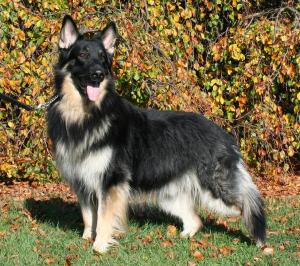
Characteristics
Learn About the Shiloh Shepherd Dog
Description
General Description
The Shiloh Shepherd’s overall appearance is rather heavy. The back is broad, strong and solid. The head is broad and noble, slightly domed and in proportion to the body. The width and length of the skull are approximately equal with a gently defined stop, strong developed cheekbones, and a gradually tapering muzzle. The muzzle should be predominantly black, the length being equal to that of the forehead, with the lips firmly fitted and solid black. The muzzle should not be long, narrow or snipey in appearance. Both upper and lower thighs are well muscled. The tail is quite long and thickly covered with dense hair, hanging down like a plume. The coat comes in two varieties: smooth and plush. The plush coat is medium-length with a dense undercoat and has a distinct mane from the neck to the chest. Hair should not be more than 5″ (12 cm) in length. The smooth coat is thick and medium-length with the outer hair being harsh to the touch.
Short History of the Shiloh Shepherd Dog
German Shepherds date back to as early as the 7th Century A.D. The German Shepherd’s roots are in the mountainous sheepdog of Germany. It is said that the breed descended from the Bronze Age wolf. In the 7th century, there was a German dog similar to the Shepherd, but lighter in coat. By the 16th century, however, the same breed had darkened in coat color. About 1880 the German army modified this breed for work as a military dog. The first German Shepherd exhibit was in 1882 in Hanover. Credit for the formation of the modern breed is given to fancier Rittmeister von Stephanitz. In 1899 German von Stephanitz began a breeding program to produce a stable, reliable shepherd dog. He combined long-haired, short-haired and wire-haired dogs from Wurtemberg, Thurginia, and Bavaria. His friend Herr Artur Meyer also helped in the breeding process, and from 1899 to 1935 Stephanitz oversaw the group that promoted the German Shepherd. Until 1915 the breed was split up into three separate versions: the long haired, the short haired, and the wire haired. Later, the wire haired became practically extinct, and these days the long haired is disqualified from the show ring. 48,000 of these dogs served in the First World War, and thus became hugely popular. They have been used for search and rescue, police, army and sentry, scent discrimination and as a guide dog. At the time, it was insulting to call anything by the name of “German”, with the war and discrimination. But English sheep herders did not want to get rid of the useful dogs, therefore they called them Alsatians, because they originated in Alsace. Finally after 40 years, in 1971, the British Kennel Club allowed the name to be German Shepherd Dog again. In 1974 Tina Barber set out to restore the German Shepherd breed to its former glory, meaning the larger version that had sounder temperament and was once so prominent in the breed. Focusing on larger size, intelligence, good temperament, and sound hips, she combined German Shepherd and Giant Malamute and changed her Kennel name to “Shiloh Shepherds”, which is where the breed gets its name. In 1990 the breed was separated from the German Shepherd in the AKC, and Barber kept all records of registries that named the breed “Shiloh Shepherd.” In 1991 the International Shiloh Shepherd Registry was established. Due to disagreements among the members, splinter groups split off to form their own Shiloh Shepherd registries. Today the Shiloh Shepherd has a small but growing number of fans and specimens.
Temperament
While their countenance may be a bit intimidating, the Shiloh Shepherd is the perfect family pet for those with children, offering a gentle and loving attitude toward all family members and even other pets. This breed is known for its calm, serene personality and extreme intelligence. Unlike some dog breeds, this is thought by many to be a pleasure to train, and is easily adaptable to almost any lifestyle or environment.
As is the case with other breeds, not all Shiloh Shepherds have the same personalities or temperaments. With this breed, much of your puppy’s personality will be influenced by its environment, whether a rural country setting, suburban home, or city apartment. The Shiloh Shepherd may develop a lack of confidence or even fearfulness when around others if it has not been properly socialized, particularly if it has been somewhat secluded during its upbringing. However, if you are looking to adopt a pet that is fiercely loyal, courageous, and the perfect watchdog, consider this magnificent, imposing breed.
Caring for Your Shiloh Shepherd Dog
General Health
Hip dysplasia (abnormal development of hip joints), skin disease, congenital heart disease, Von Willebrand’s disease, nervous condition, panosteitis (inflammation of long bones in the legs and low thyroid), autoimmune disorders, and digestive problems, and bloat. Bloat is a common health problem for most dogs, being the second largest killer of dogs second to cancer. Shiloh Shepherds are susceptible to it because of their deep chests. It is also known as twisted stomach or gastric torsion.
.
Grooming & Bathing
The Shiloh Shepherd needs little grooming. The smooth variety does not need to be brushed, but the plush variety should be brushed at least once a week. They may need more brushing if they’re shedding all over the house is a problem. They should not be bathed except once or twice a year so their skin does not dry out. The Shiloh Shepherd requires frequent exercise, so they should be walked and allowed to run off leash. They should also do activities which stimulate their mind and their body.
Exercise & Training
Take them for brisk walks or runs every day or as often as possible. A great jogging partner, they very much enjoy outdoor activity. Regular exercise is a must for this breed. Regular brushing takes care of either coat type. The Smooth variety requires less work but the Plush variety sheds less. Extremely intelligent and easy to train, Positive re-enforcement works well in most situations. Shiloh Shepherds are one of the most capable and trainable breeds, they are eager to learn and to work and excel at the highest levels of competition.

